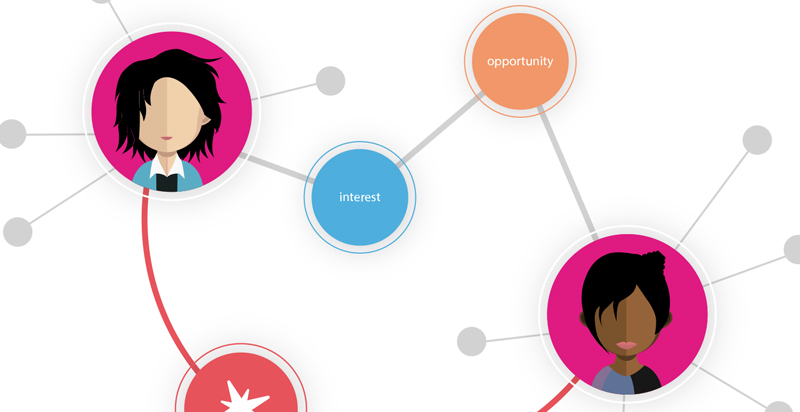At the beginning of the year we posited that those of us who work with complex data need to move away from rows and columns and move towards graphs when thinking and working with our data. The first step is creating your model. This step is critical, and unfortunately, in my opinion, it is the least fun, mostly because this step is hard. We'd like to immediately be able to create cool network diagrams and query the data to find unique and innovative match-ups, but starting with the model is often the most non-intuitive, and over-looked step. So, while I want to jump into creating mind-blowing data visualizations, we are going to spend a bit more time with models and data entry. We want to ensure that you get the value in being able to generalize the problem you are mapping out.
Read More »Blog
Share Your Work to Innovate
I presented at the ISPIM Conference in 2020 (ISPIM: International Society of Professional Innovation Management) on how co-production can bridge the gap between academic research and industry use-cases creating shared, collective intelligence. Co-production in this context is people with different skills and areas of expertise working on a common goal. By sitting at the intersection of these divergent perspectives, co-product marries aspects of each viewpoint, bringing ideas born in research to life in industry.
Read More »Use Data, Technology, and Intention to Optimize Team Building
Cleaning data is often the primary job of the data scientist, and not necessarily the one they signed up for. While getting the "words" right with computers is important, it is not fraught with the nuance that getting words right with humans is. Across disciplines the same word can have entirely different meanings and this miscommunication is only one aspect of team building that can go awry.
Read More »The Best Innovation Management Software for Complex Problems
Some problems are complicated. Finding a solution requires expertise and analysis, but the solution exists. Sky scrapers are complicated. Some problems are complex or even wicked. These problems have no solution. They’re too big, too slippery, too thorny.
Read More »What Neuroscientists and Software Developers Discovered in a One-Day Hackathon
The goal: investigate huge amounts of research data in new ways. The pool for teams: neuroscientists, data scientists, and software developers. The result: answering questions we didn’t even know we had.
Read More »In Stanley Kubrick’s famous film based on Arthur C. Clark’s book, 2001: A Space Odyssey, a mysterious black monolith appears on Earth millions of years before modern humans. It’s the classic “black box.” We don’t know who made it, what’s in it, or how it works, but it’s miraculous and powerful and somehow results in jumpstarting the entire evolution of humankind.
Read More »Have you ever read the book Travels with Charley by John Steinbeck? The first part of the book is John Steinbeck talking about his lifelong affliction with wanderlust. I spent a few years living out of a VW camper van, indulging my own wanderlust affliction, so the book quickly claimed a special place in my heart. Steinbeck is such a skilled writer, and he describes the feeling -
Read More »Mapping Science Networks and Projects to Limit the Rise in Global Temperatures
When the United Nations released a report earlier this year that a catastrophic two-degree Celsius (3.6-degree Fahrenheit) rise in global average temperatures is expected to occur in the next decade, there was a media firestorm about the dire predictions. You know who wasn’t surprised? Climate scientists. (Read about the difference a half-a-degree can make.)
Read More »If every ‘new’ idea is derivative, derive them.
Everything is derivative. Take advantage of that. “New” ideas are the next step in an extensive network of existing people and ideas. If we can get the data and reconstruct the network, we can analyze it and understand where branches of a network have the potential for innovation.
Read More »Using Science to Build a Dynamic Collaboration Engine
“Good ideas are getting harder to find,” Exaptive CEO Dave King quotes from a recent paper by MIT and Stanford researchers. He points to the skyrocketing number of researchers employed in the U.S. and contrasts it with the inverse slope on a chart monitoring efficiency of researchers along the same timeline. “Those growing number of researchers are failing to produce value that outpaces what we’re spending to innovate.”
Read More »Recent Posts
Posts by Author
- AIBS BioScience Talks (1)
- Alanna Riederer (1)
- Austin Schwinn (2)
- Clive Higgins (3)
- Dave King (7)
- Derek Grape (2)
- Dr. Alicia Knoedler (2)
- Frank D. Evans (4)
- Jeff Johnston (1)
- Jill Macchiaverna (9)
- Josh Southerland (1)
- Ken Goulding (1)
- Luke Tucker (3)
- Matt Coatney (3)
- Matthew Schroyer (4)
- Mike Perez (10)
- Sandeep Sikka (1)
- Shannan Callies (2)
- Stephen Arra (1)
- Terri Gilbert (2)
- Tom Lambert (2)
Posts by Tag
- Innovation (19)
- collaboration (19)
- team building (17)
- Data Applications (15)
- Data Science (14)
- collaborate (13)
- new idea (13)
- Data Visualization (12)
- cognitive city (11)
- cognitive network (11)
- teambuilding (11)
- discovery (10)
- thought leadership (10)
- Exaptation (9)
- research (9)
- technology (8)
- Data Exploration (7)
- Platforms (7)
- Data + Creativity (6)
- Text Analysis (6)
- open data (6)
- software (6)
- tech (6)
- Big Data (5)
- Network Analysis (5)
- conference (5)
- ethnographics (5)
- human-computer interaction (5)
- innovation software (5)
- network diagrams (5)
- Communicating About Data (4)
- Dataflow Programming (4)
- Design (4)
- HCI (4)
- Platform (4)
- Rapid Application Development (4)
- artifact (4)
- co-production (4)
- innovation management software (4)
- startup (4)
- use case (4)
- women in tech (4)
- attribute (3)
- entrepreneurship (3)
- ethnographic (3)
- ethnography (3)
- Abstraction (2)
- Data-driven Decision Making (2)
- Machine Learning (2)
- PubMed® Explorer (2)
- User Interface (2)
- algorithm (2)
- entrepreneur (2)
- 3d Visualization (1)
- Financial (1)
- Netflix (1)
- building models (1)
- hackathon (1)
- hairballs (1)
- interdisciplinary (1)
- knowledge graph (1)









